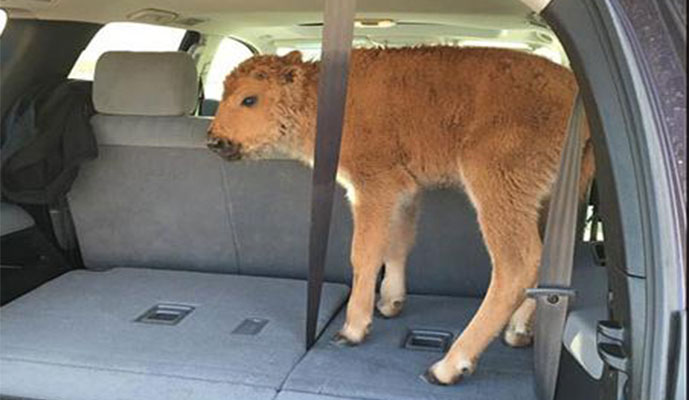We have much more to do and your continued support is needed now more than ever.
Misguided Tourists “Rescue” Bison Calf

As a wildlife conservation professional, when I see stories like this, my first reaction is to think, why would anyone think it’s ok to pick up a wild animal? Especially one whose mother could easily obliterate you. Why would someone steal a baby animal from the wild and realistically expect to dump it on someone else to take care of for the rest of its life? Then I remind myself that when things like this happen, people genuinely believe they are doing a good thing.
The Reality
Here’s the harsh truth: the natural world is tough. Not every individual survives. If they did, the ecosystem would crash. Babies are particularly vulnerable. But wildlife species are also supremely adapted to their environment. They are built to survive. In a healthy ecosystem, enough individuals survive to perpetuate their species. Those that don’t survive provide critical nutrients to other wild animals. If the baby bison was separated from its mother due to natural reasons, it likely would have become food for other wildlife such as wolves, bears, coyotes, ravens or magpies. That’s how nature works.
There’s a beauty to the complex balance of this reality of life on this planet that seems to completely escape many people, and that’s a real shame.
As people who work in wildlife education and conservation, we aim to help people understand wildlife and rules of the natural world. It can be an uphill battle when movies, celebrities, the extreme animal rights movement, and popular culture in general promote the idea that wild animals are in need of coddling and “protection” in the form of kidnapping them from the wild.
Helping wildlife doesn’t mean treating them like our pets or children. Wildlife conservation isn’t about rescuing every individual animal. It’s about making sure that wildlife populations are healthy and that they have enough quality habitat to continue to exist and play their role in the ecosystem.

How to Help
If a wild animal is injured or in danger as the direct result of human activity, that’s a different thing. Helping domesticated species under our care is a different thing. But even then, it’s best left to professionals with the training, licensing, and/or legal authority to help.
Before intervening, make sure you know for sure if the animal is really in danger (which goes for deer fawns, rabbits and baby birds as much as bison). The tourists should have notified park rangers of the bison and let them make the call on how to respond (or not) rather than taking matters into their own hands. Once the tourists intervened, rangers were then obligated to do the same.
Some have criticized park rangers for euthanizing the animal after the herd rejected it when they tried to reintroduce it, saying they should have given it to a “sanctuary” of some kind. That is a natural reaction, but unrealistic. Such facilities are few and far between, and they are often understaffed, underfunded and already filled to capacity. How many of those that do exist have the know-how and facilities to care for a bison? How many are close enough to where this happened to realistically get the bison to them? Even if they did find such a facility, there’s no guarantee the bison would have fed from a bottle.
Euthanizing the bison was most humane thing to do once the tourists had intervened and taken it out of the wild. Getting this bison to a captive facility isn’t the solution to the problem – educating people not to unnecessarily intervene in nature is.
Having compassion for animals is a good thing. Trying to “rescue” wildlife from their natural environment is misguided at best, and can have disastrous results, as it did in this case. The people who put this baby bison in their car really did it out of compassion. They wanted to help. But they did the wrong thing. Channeling that compassion into the bigger conservation picture is the best way to help. We should focus on efforts to save bison as a species, protect their habitat and restore them to their former range.
Take ActionHelp make sure that wild bison always have place to roam free.






















